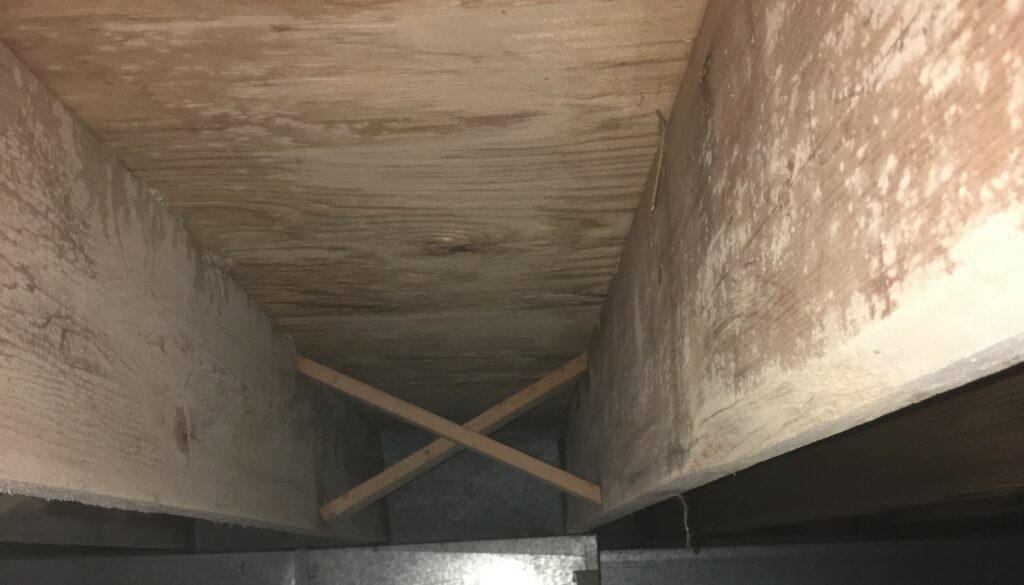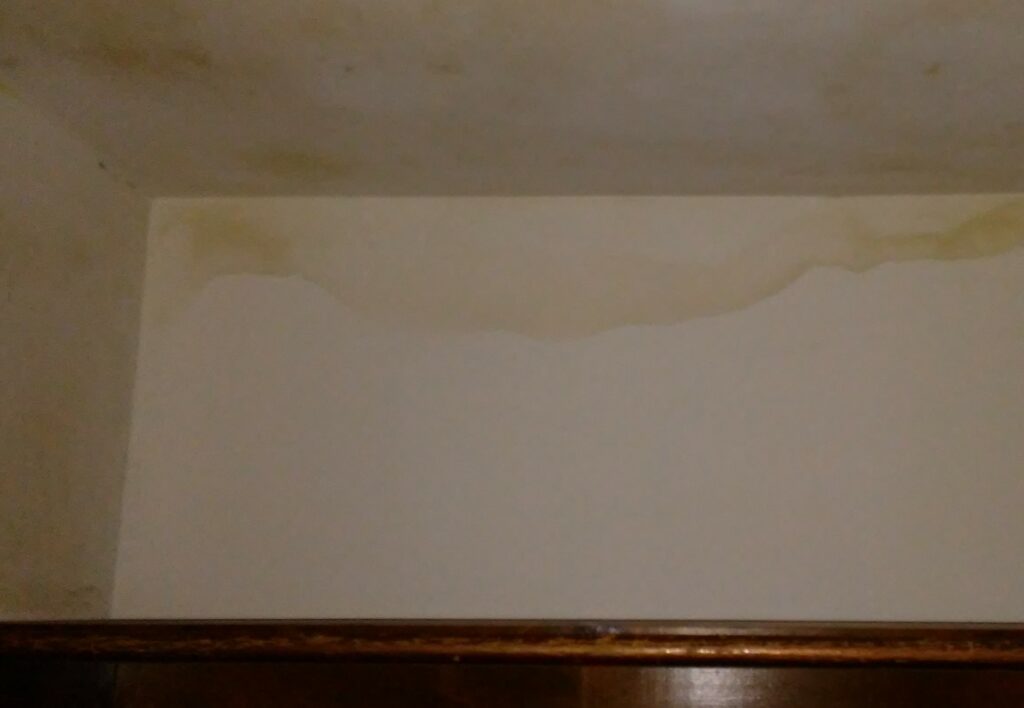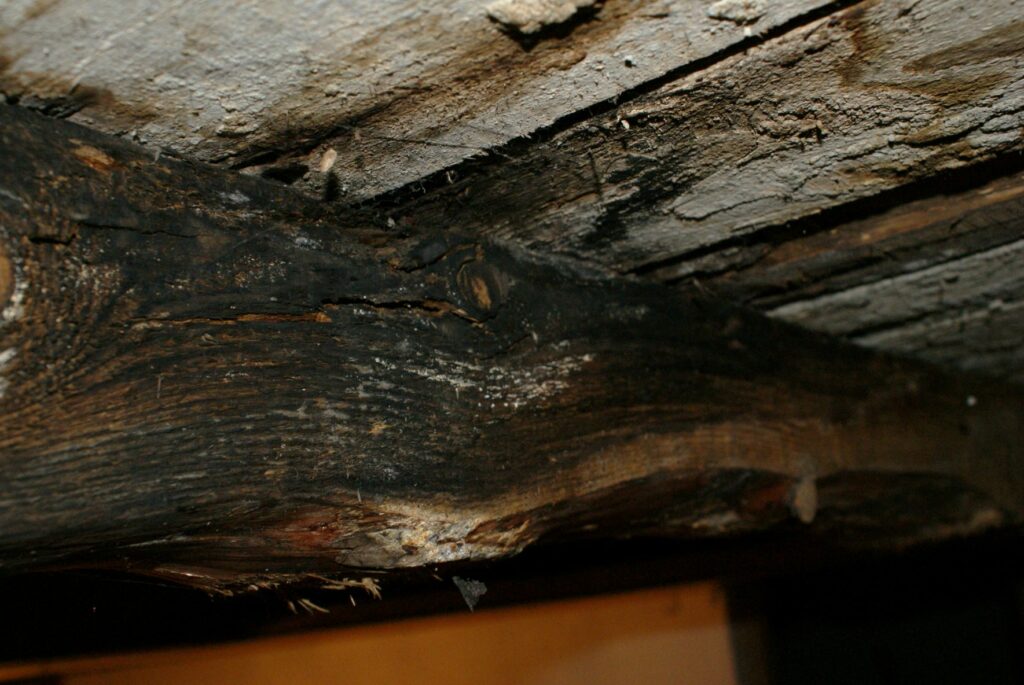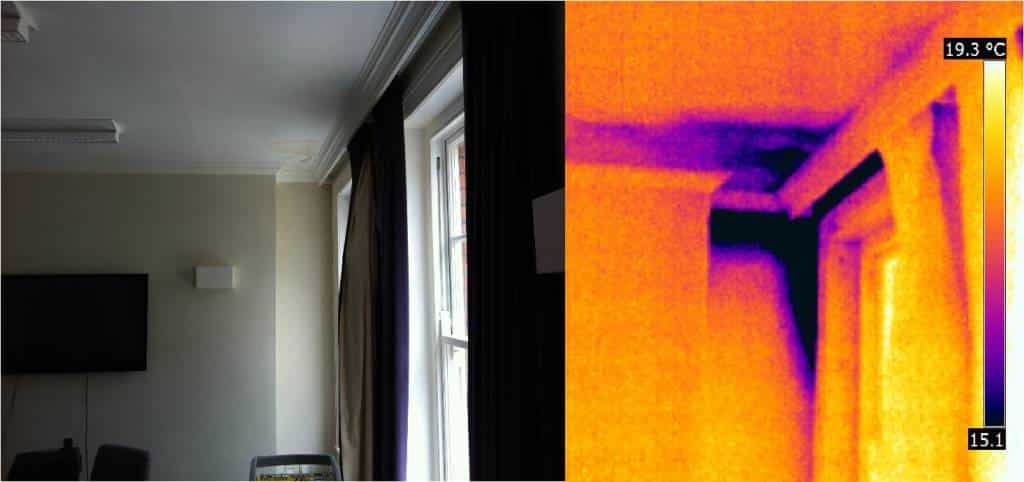Do you know what’s lurking in the corners of your home? Mold can be a very sneaky intruder, growing undetected and wreaking havoc on your home and health. Whether you’re a homeowner, renter, or landlord, it’s crucial to be aware of the warning signs of mold in your home. In this article, we’ll reveal the top ten red flags that could indicate a mold problem, and show you how to take proactive steps to prevent its spread.
Here are 10 common warning signs of mold in your home:
- Visible Mold Growth
- Musty Odor
- Water Stains
- High Humidity Levels
- Peeling Paint or Wallpaper
- Dampness or Condensation
- Cracked or Warped Walls
- Allergic Reactions
- Respiratory Problems
- Chronic Fatigue or Headaches
1. Visible Mold Growth
It may sound obvious to say that visible mold growth is a sign of mold in your home, but don’t discount it. Mold can hide throughout the home wherever moisture is present but can even hide in plain sight (as shown below) on surfaces in your home!
Mold can grow in a variety of colors and textures, including black, white, green, and brown, and may appear fuzzy, slimy, or powdery. It’s also important to note that just because visible mold appears black in color, doesn’t guarantee that it is the dreaded “black mold” (Stachybotrys) as many other molds are often black or dark in color.

If you do see mold growing on walls, ceilings, floors, or other surfaces, it is important to take action to eliminate the mold and address the underlying cause of the problem.
2. Musty Odor
One of the most common warning signs of mold growth is a stale, musty odor that permeates the whole home, or one area in particular. This musty odor tends to start off faint and grow stronger over time.
As mold grows, it releases microscopic contaminants into the air like mycotoxins and microbial volatile organic compounds (mVOCs), including pungent chemicals like aldehydes, benzenes, carboxylic acids, and terpenes. When mixed together, these chemicals give off unpleasant smells that can be described as musty, stale, earthy, or damp.
While this smell might seem similar to other common household odors, like damp laundry, if you notice this musty odor without an obvious source, there’s a chance you might have hidden mold growth lurking somewhere.
3. Water Stains

Water stains on walls, ceilings, or floors are a key indicator of a water leak, which if left unresolved, will likely lead to mold growth. If you notice water stains in your home, it is important to find the source of the moisture intrusion and repair it as soon as possible to prevent further damage and potential mold growth.
While most people look at a water stain as a bad thing, because not all water damage is visible, quickly identifying this visible indicator can allow you to take action to fix the issue before you have a larger problem hiding behind your walls or beneath your floors. Remember, water takes the path of least resistance and can find its way into cracks and crevices very easily.
4. High Humidity Levels
Excess humidity in your home can be a significant contributor to potential mold growth. Mold thrives in humid environments, so it’s important to monitor the humidity levels in your home and maintain them below 60% to prevent the possibility of humidity-caused mold growth. While any mold contamination in your home presents a possible problem, this source of mold growth often leads to significant damage quickly, as the growth is often not contained to a single area. This can often lead to the loss of personal possessions, or significant expenses to remove the mold from both your home and belongings.
There is a way to avoid all these headaches, though! A hygrometer can help you measure the humidity levels, and if you notice they consistently read above 58-60%, it’s time to take action. Some effective ways to reduce humidity levels include using a dehumidifier, improving ventilation, fixing leaks, and regularly using exhaust fans in high-moisture areas like bathrooms and kitchens. By keeping the humidity levels in check, you can significantly reduce the risk of mold growth in your home.
5. Peeling Paint or Wallpaper

Peeling paint or wallpaper in your home is a common warning sign of potential water damage and mold growth. Moisture is often the culprit behind peeling paint or wallpaper, as it can cause the adhesive to loosen and the materials to bubble and peel away from the surface. Because of the moisture that causes this problem, these areas of damage provide an ideal environment for mold spores to take hold and grow. If left unaddressed, the mold can continue to spread and cause more significant damage to your home and potentially pose health risks to you and your family. Therefore, it’s crucial to investigate any instances of peeling paint or wallpaper and address the underlying cause of the moisture before it leads to mold growth.
6. Dampness or Condensation
Condensation, or dampness, represents more than enough of the moisture that mold needs to begin growing indoors. Mold spores are present in the air, but they need moisture and a food source (like dust, sheetrock, or organic materials) to grow. When there is too much moisture in the air, mold can quickly start to grow on surfaces such as walls, ceilings, and floors.

If you notice areas of dampness or condensation in your home, it is important to quickly address the underlying cause. This could be a sign of a leaky pipe or roof, poor ventilation in your bathroom, or even inadequate insulation in your home. Here are some possible causes of excess moisture:
Leaky Pipes or Roof
If you have a leaky pipe or roof, water can quickly seep into your walls or ceiling and cause mold growth. It’s important to fix any leaks as soon as possible to prevent further damage.
Poor Ventilation
If your bathroom or kitchen is poorly ventilated, steam and moisture from cooking or showering can build up in the air, causing condensation on surfaces. Make sure your bathroom and kitchen have proper ventilation, such as exhaust fans or open windows.
Inadequate Insulation
If your home is not properly insulated, cold surfaces such as windows or walls can cause interstitial condensation when warm, moist air comes into contact with them. Many times, this can be solved by simply adding additional insulation to prevent the problem, though other approaches like vapor barriers could be relevant depending on the surrounding environment.

7. Cracked or Warped Walls
When mold grows on a surface, it can cause damage to the material it is growing on. This is due to the enzyme that mold produces which breaks down the organic matter in the material, weakening and damaging it. As the mold grows, it also produces hyphae, which are thread-like root structures that penetrate and feed on the material. This can also cause the material to become weakened and eventually warp or crumble.
Mold can cause damage to the surfaces it grows on, so if you notice cracked or warped walls, it could be a sign of mold growth. This damage can occur as a result of the mold expanding and growing within the surface.
If you notice cracked or warped walls in your home, it could be a sign of moisture intrusion or mold growth. It’s important to have a professional inspect the area to determine the cause of the damage and to identify any potential mold growth.
8. Allergic Reactions
While some types of mold are largely harmless, others can produce allergens, irritants, and microscopic toxins that can trigger allergic reactions in some people. When mold spores are inhaled, they trigger the immune system (severity can vary greatly) and cause the body to exhibit an allergic response. This is similar to the types of symptoms associated with any allergy reaction, including:
- Sneezing
- Runny or stuffy nose
- Wheezing or shortness of breath
- Eye irritation, such as redness, itching, or burning
- Skin irritation, such as rash or hives
For people dealing with chronic respiratory issues, exposure to mold can significantly exacerbate the respiratory symptoms, and even cause other, potentially life-threatening health complications.
9. Respiratory Problems
Exposure to mold can cause respiratory problems in addition to allergic reactions. When mold spores are inhaled, they can irritate the respiratory system, causing inflammation and other symptoms. For people with respiratory conditions, such as asthma or chronic obstructive pulmonary disease (COPD), exposure to mold can exacerbate their symptoms and make breathing more difficult.
Symptoms of respiratory problems often caused by mold exposure include:
- Difficulty breathing
- Chest tightness
- Wheezing
- Coughing
- Shortness of Breath
These symptoms can range from mild to severe, and they can be particularly dangerous for people with pre-existing respiratory conditions. In some cases, exposure to mold can lead to the development of respiratory infections, such as bronchitis or pneumonia.
If you have a pre-existing respiratory condition, it’s important to speak with your doctor about ways to manage your symptoms and minimize your exposure to mold. This may include taking medications to manage your symptoms or using an air quality system to remove mold spores (and other contaminants) from your indoor air. With the right treatment and precautions, though, you can quickly reduce your risk of respiratory problems caused by mold exposure.
10. Chronic Fatigue or Headaches
Mold exposure can cause a variety of health problems, including chronic fatigue and headaches. When mold spores are inhaled, they can trigger an immune response, causing inflammation and other symptoms throughout the body.
Chronic fatigue is a complex condition characterized by persistent fatigue that is not relieved by rest or sleep. It is thought to be caused by a variety of factors, including viral infections, hormonal imbalances, and immune system dysfunction. Mold exposure can also contribute to chronic fatigue by triggering the immune response that then disrupts the body’s normal functioning.

In addition to chronic fatigue, mold exposure can also cause headaches. These headaches may be caused by the inflammation and irritation that mold spores can cause in the respiratory system. The headaches may be accompanied by other symptoms, such as nasal congestion, sinus pressure, and eye irritation. Mold exposure can also cause other neurological symptoms, such as memory loss, difficulty concentrating, and dizziness. These symptoms may be the result of the inflammation and irritation that mold spores can cause over time in the brain.
If you are experiencing chronic fatigue, headaches, or any other symptoms that may be related to mold exposure, it’s important to speak with your doctor. They can help you identify the cause of your symptoms and develop a treatment plan to manage them. Additionally, if you suspect that you have a mold problem in your home, it’s important to have it professionally inspected and removed, if necessary, to minimize your risk of exposure.
Though mold is an elusive intruder within our homes, bringing with it a host of potential problems for both the building and its occupants, we hope this article has equipped you with the knowledge to identify these early warning signs for mold (and moisture) in the home and prevent further damage. By identifying these warning signs quickly, you can take action to address the underlying cause of the moisture and prevent mold growth from ever taking hold in your home.
Remember that prevention is key, and taking proactive steps to reduce moisture levels in your home can help you avoid the headaches and costs associated with mold remediation.
If you do discover mold growth in your home, it’s essential to act quickly and enlist the help of a professional mold remediation company to handle the problem safely and effectively. With the right knowledge and resources, you can Breathe Easy knowing your home and family are protected from the dangers of mold.
